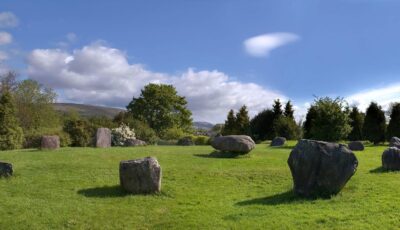Ireland, before it became Christian, was fundamentally pagan. The Celts, in particular, had helped to establish numerous traditions and rituals based on beliefs in nature, the cycle of life and the seasons. Within this framework, Druidism was an inextricable component of Celtic society. But what was Druidism really, and what role did these famous druids play in Irish society in days gone by?
In ancient Ireland, druids played a key role in society. No mere priests, they were central to the Celtic population as advisors, judges, healers and guardians of tradition.
Highly respected, their power extended both spiritually and intellectually, and they were regarded as respected scholars, trained over decades to master knowledge of nature, rituals, astronomy and tribal laws.
But that’s not all! Druids also played a political role, advising kings and other tribal chiefs, and their influence extended to all aspects of Celtic life. They were considered intermediaries between gods and men, and their wisdom was revered.
Druidism was intimately linked to nature, each element of which was perceived as sacred and inhabited by spiritual forces. Trees, in particular, had a special place in Druid cosmology. The oak, in particular, was venerated as a symbol of strength and longevity, and forests were often the setting for Druid ceremonies. This connection with trees gave rise to the concept of the “tree of life”, a symbol that can still be found today in Irish art and culture.
The Druids believed that nature was a reflection of the divine, and that every part of it had a role to play in the balance of the universe. They organized seasonal rituals to honor nature’s cycles, particularly during the solstices and equinoxes, which marked the turning points of the year.

Kenmare Stone Circle – A Ryan – cc
Druidic ceremonies often took place in sacred open-air sites, such as forests or hills. The rituals were intended to honor the forces of nature and the deities who ruled over various aspects of life.
Some rituals included animal sacrifices, and according to some ancient sources (albeit subject to doubt), there may have been human sacrifices in very specific contexts.
Druids also mastered the art of divination, interpreting signs in nature – such as the flight of birds or the movement of water – to predict the future or guide their decisions. They also used plants and herbs to heal, each plant being associated with a specific spiritual or medicinal property.
One of the major characteristics of Druidism was the importance of orality. Druids did not write anything down, believing that knowledge should be memorized and passed on verbally to preserve its purity and prevent it from being distorted. This led to the loss of many Druidic teachings with the arrival of Christianity, with writings on Druidism coming almost exclusively from outside sources, often Roman, who did not always grasp the essence of this spirituality.
This oral tradition, however, enabled a great fluidity in the transmission of stories, laws and spiritual teachings, with a deep connection to poetry and music as means of expressing sacred truths.
The arrival of Christianity in Ireland from the 5th century onwards gradually marginalized Druidism. Christian monks, while sometimes respecting ancient local traditions, gradually imposed their own worldview. However, the transition was not abrupt. For several centuries, Druidism and Christianity coexisted in Ireland, with a partial integration of Druidic beliefs and rituals into early Irish Christianity.
Many ancient Druidic sites became Christian pilgrimage sites, and certain figures, such as Saint Brigitte, may reflect this hybridization between the pagan goddess Brigid and the Christian saint.
Ancient Druidism may have disappeared, but it has not been totally forgotten. Today, a neo-Druidic movement has sprung up in Ireland and elsewhere, seeking to revive the ancient spiritual practices of the Celts.
Although neo-Druidism is largely a modern reconstruction, it draws deeply on the ancient teachings, emphasizing nature, spiritual balance and a respectful relationship with the environment.
This return to Celtic spiritual roots shows that, even thousands of years later, the wisdom of the Druids continues to fascinate.